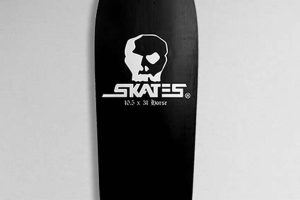Controller connectivity issues within the Session: Skate Sim environment on a personal computer refer to a specific problem where the game fails to recognize or properly interface with a user’s gamepad or joystick. This can manifest as a complete lack of response from the controller within the game, intermittent functionality, or incorrect button mappings, thereby hindering the player’s ability to effectively control the skater.
Proper controller support is crucial for an immersive and enjoyable gaming experience, particularly in simulation games such as Session: Skate Sim, where precise control over movement and tricks is paramount. Addressing these connectivity problems allows players to fully realize the game’s potential, fostering engagement and promoting a more authentic skateboarding simulation. Historically, similar challenges have plagued PC gaming, necessitating ongoing efforts from developers to ensure robust and reliable peripheral support.
Consequently, the subsequent sections will address potential causes of, and solutions to, controller connectivity problems in Session: Skate Sim. Diagnostic steps will be outlined, driver-related issues explored, in-game configuration adjustments detailed, and hardware troubleshooting methods presented.
Troubleshooting Controller Connectivity in Session
The following recommendations provide a structured approach to resolving controller connectivity issues encountered while playing Session: Skate Sim on a personal computer.
Tip 1: Verify Basic Connectivity. Ensure the controller is physically connected to the PC via a functional USB port. Test the controller’s functionality in other applications or games to confirm it is operational. If the controller is wireless, confirm it is properly paired and charged.
Tip 2: Update Controller Drivers. Outdated or corrupted controller drivers can cause communication problems. Access Device Manager in Windows to locate the controller and update its drivers. Download the latest drivers from the manufacturer’s website if necessary.
Tip 3: Examine In-Game Controller Settings. Within the Session: Skate Sim settings menu, navigate to the controller configuration section. Verify that the game recognizes the connected controller and that the correct input device is selected. Attempt to reconfigure controller mappings if needed.
Tip 4: Investigate Steam Input Interference. If playing through Steam, Steam Input may interfere with direct controller communication. Try disabling Steam Input for Session: Skate Sim by right-clicking the game in your Steam library, selecting Properties, and navigating to the Controller section. Choose “Disable Steam Input.”
Tip 5: Check for Conflicting Devices. Other input devices connected to the PC, such as joysticks or steering wheels, can sometimes cause conflicts. Disconnect any unnecessary peripherals to isolate the issue and determine if a conflict exists.
Tip 6: Run the Game as Administrator. In certain instances, the game may require elevated privileges to properly access the controller. Right-click the Session: Skate Sim executable file and select “Run as administrator.”
Tip 7: Verify Game File Integrity. Corrupted or missing game files can disrupt controller functionality. Within Steam, right-click Session: Skate Sim, select Properties, navigate to the Local Files tab, and click “Verify integrity of game files.” This process will automatically download and replace any damaged files.
Implementing these troubleshooting steps methodically can often resolve the most common controller connectivity problems in Session: Skate Sim, enabling optimal game control.
The next section will delve into more advanced troubleshooting, including hardware diagnostics and operating system configurations.
1. Driver Incompatibility
Driver incompatibility represents a significant barrier to successful controller functionality within Session: Skate Sim on a personal computer. This issue arises when the software interface mediating communication between the controller and the operating system is outdated, corrupted, or otherwise incompatible with either the game or the hardware.
- Outdated Driver Versions
Older controller drivers may lack the necessary protocols or instructions required for seamless interaction with Session: Skate Sim. As games evolve, they often incorporate new input methods or rely on updated operating system functionalities. Consequently, drivers that have not been updated to reflect these changes may fail to properly translate controller inputs, resulting in a non-responsive or malfunctioning controller within the game.
- Corrupted Driver Files
Driver files can become corrupted due to various factors, including system errors, incomplete installations, or malware infections. A corrupted driver may lead to instability or a complete failure of the controller to communicate with the operating system and, by extension, Session: Skate Sim. The system might recognize the controller’s presence, but the game will not receive any input signals.
- Generic vs. Specific Drivers
Operating systems often provide generic drivers for common input devices. While these generic drivers may enable basic functionality, they may not fully support all the features of a specific controller or be optimized for the demands of a game like Session: Skate Sim. Installing the manufacturer-provided, device-specific driver is generally recommended to ensure optimal performance and compatibility.
- Operating System Compatibility
Certain controller drivers may be designed for specific versions of the operating system. Using a driver intended for an older or newer operating system than the one installed on the computer can lead to incompatibility issues. Session: Skate Sim may rely on specific operating system APIs to interact with controllers; incompatible drivers can disrupt this process.
Addressing driver incompatibility necessitates identifying and installing the appropriate, up-to-date, and uncorrupted driver for the specific controller and operating system in use. Failure to do so will invariably result in the controller failing to operate correctly within Session: Skate Sim, hindering the player’s ability to control the game effectively.
2. Steam Input Conflict
Steam Input, a feature integrated into the Steam platform, provides a layer of abstraction between a controller and a game. While intended to enhance controller compatibility, Steam Input can inadvertently interfere with Session: Skate Sim’s native controller support, leading to a failure in establishing a direct connection. This conflict arises when Steam Input is configured to intercept controller signals before they reach the game, potentially misinterpreting or overriding the intended inputs. For example, a user may have globally enabled Steam Input for generic gamepad support, which then forces Session: Skate Sim to rely on Steam’s interpretation of the controller’s signals, rather than the game directly communicating with the device. This can lead to unresponsive controls, incorrect button mappings, or a complete lack of recognition of the controller by Session: Skate Sim.
The prevalence of Steam Input conflicts is particularly noticeable when Session: Skate Sim already possesses robust native controller support. In such cases, Steam Input introduces an unnecessary intermediary layer that can disrupt the established communication pathway. Disabling Steam Input specifically for Session: Skate Sim often resolves these connectivity issues, allowing the game to directly interface with the controller. This process involves navigating to the game’s properties within the Steam library and opting out of Steam Input management for that particular title. This prevents Steam from imposing its own controller configuration, thereby enabling the game to recognize and utilize the controller natively.
In summary, Steam Input, though designed for enhanced controller support, may act as a barrier in Session: Skate Sim by overriding or misinterpreting controller signals. Identifying and mitigating this conflict by disabling Steam Input for the game frequently rectifies the ‘session skate sim wont connect to controller pc’ problem, enabling seamless and direct controller integration. Understanding this potential conflict is vital for troubleshooting controller issues within the Steam environment.
3. Hardware Malfunction
A hardware malfunction directly impacts the ability of Session: Skate Sim to establish a connection with a controller on a personal computer. Hardware failures can manifest in various forms, including damage to the controller itself, a faulty USB port, or internal component failures within the computer affecting peripheral communication. When the controller’s internal circuitry is compromised, it may fail to transmit input signals or transmit corrupted signals, preventing the game from registering any commands. A defective USB port, similarly, can disrupt the flow of data between the controller and the computer, resulting in an incomplete or nonexistent connection. For instance, a user may experience intermittent controller responsiveness or complete controller failure if the USB port is damaged or the cable is frayed. Diagnostic software might not detect the controller at all in such instances. The absence of a functional hardware link fundamentally prevents Session: Skate Sim from recognizing and responding to controller input.
Consider a scenario where a gamer has repeatedly dropped their controller, leading to internal damage of the circuit board. Although the controller may initially appear functional, its ability to consistently transmit commands deteriorates, leading to unpredictable in-game behavior or a complete inability to control the skater. Another example involves a computer experiencing power fluctuations that damage the USB controller chip on the motherboard. This damage may not be immediately apparent, but it prevents the reliable detection of input devices, including the gamepad used for Session: Skate Sim. Identifying hardware malfunctions requires thorough testing, potentially involving using the controller on another computer, testing alternative USB ports, or employing diagnostic tools to assess the hardware’s integrity. The ability to differentiate between a hardware failure and a software issue is a vital troubleshooting step when addressing controller connectivity problems in Session: Skate Sim.
In summary, a malfunctioning controller or associated hardware component serves as a definitive barrier to proper game control in Session: Skate Sim. Resolving “session skate sim wont connect to controller pc” requires a systematic examination of the hardware, followed by either repair or replacement of the defective component. Ignoring the possibility of a hardware malfunction can lead to prolonged and ultimately fruitless software-based troubleshooting efforts. Addressing hardware issues directly is crucial for restoring the intended gaming experience.
4. Game Configuration
Improper in-game settings often contribute to scenarios where Session: Skate Sim fails to recognize or properly utilize a connected controller on a personal computer. Incorrect configurations within the games options menu can directly impede controller functionality, regardless of the controller’s hardware integrity or driver status.
- Incorrect Input Device Selection
Session: Skate Sim typically presents a list of available input devices detected by the operating system. If the user mistakenly selects the wrong device (e.g., a virtual input device or an inactive controller), the game will attempt to read input from an incorrect source. For example, if a user has a virtual joystick program installed and the game defaults to that virtual device instead of the actual gamepad, no inputs will be registered from the physical controller. This misidentification results in a non-responsive controller experience, even if the controller is properly connected and functional.
- Improper Button Mappings
Game configuration settings allow for customization of button mappings, assigning specific in-game actions to particular controller buttons. If these mappings are incorrect, incomplete, or entirely absent, the controller may appear non-functional, despite being recognized by the game. For instance, if the “ollie” action is inadvertently unmapped or assigned to a nonexistent button, the player will be unable to perform this core maneuver, creating the impression of controller failure. Similarly, conflicting mappings, where multiple actions are assigned to the same button, can lead to unpredictable behavior and inhibit proper control.
- Disabled Controller Support
Some games offer a toggle to enable or disable controller support, primarily intended for users who prefer keyboard and mouse input. If controller support is inadvertently disabled within Session: Skate Sim’s settings, the game will ignore all input from the connected gamepad, regardless of its operational status. This setting effectively overrides the system’s ability to recognize and process controller signals, rendering the gamepad useless within the game environment. Users must ensure that controller support is explicitly enabled in the game’s configuration to allow the system to recognize and respond to gamepad inputs.
- Sensitivity and Deadzone Settings
While not directly causing a complete connection failure, improper sensitivity and deadzone adjustments can mimic controller malfunction. Excessively low sensitivity settings might make the controller appear unresponsive, as minimal stick movements fail to register in the game. Conversely, overly high sensitivity settings can make the game difficult to control accurately. Inappropriately large deadzones can create a lag between physical controller input and the corresponding in-game action, giving the impression of poor controller responsiveness. Addressing these sensitivity and deadzone issues is critical for fine-tuning the controller experience and ensuring accurate and responsive control within Session: Skate Sim.
Ultimately, accurate game configuration is a critical determinant of controller functionality in Session: Skate Sim. Addressing misconfigured input device selections, button mappings, controller support settings, and sensitivity adjustments is essential for resolving situations where the game fails to properly respond to a connected controller, effectively resolving the “session skate sim wont connect to controller pc” issue.
5. USB Port Failure
USB port failure constitutes a primary physical impediment to controller connectivity in Session: Skate Sim on a personal computer. A non-functional USB port prevents the essential data transfer between the controller and the system, rendering the controller entirely unresponsive within the game. The absence of a reliable physical connection negates any software-based solutions, making USB port functionality a critical prerequisite for controller operation. For example, a damaged USB port, whether due to physical trauma or electrical surge, may fail to supply power to the controller or transmit the necessary input signals to the operating system. In this scenario, the computer might not even detect the controller’s presence, resulting in a complete lack of input response within Session: Skate Sim. This understanding of USB port failure as a root cause is essential for effective troubleshooting; addressing driver issues or game settings is futile if the underlying physical connection is compromised.
The diagnosis of USB port failure often involves a process of elimination. Initially, testing the controller on alternative USB ports is crucial. If the controller functions correctly when connected to a different port, the original port is likely faulty. Furthermore, using other USB devices to test the port’s functionality can provide additional confirmation. If other devices also fail to operate correctly in the same port, it reinforces the likelihood of a hardware problem. Practical application of this knowledge extends to preventive measures, such as avoiding excessive force when connecting or disconnecting USB devices and protecting the computer from power surges. Recognizing the signs of a failing USB port allows for timely intervention, preventing potential disruptions to the gaming experience.
In conclusion, USB port failure represents a fundamental obstacle to controller connectivity within Session: Skate Sim. The inability to establish a stable physical connection between the controller and the computer effectively halts all communication, regardless of software configurations. Thorough diagnosis and proactive maintenance of USB ports are vital for mitigating this particular cause of controller malfunction, ensuring a consistent and reliable gaming experience. The challenge lies in identifying hardware issues early, before significant troubleshooting efforts are expended on software-related factors. Addressing this specific problem requires a focus on hardware diagnostics, confirming that the basic physical connection is sound, before proceeding to more complex troubleshooting steps.
Frequently Asked Questions
This section addresses common questions regarding controller connectivity problems encountered while playing Session: Skate Sim on a personal computer. The following information aims to provide clarity and assist in troubleshooting efforts.
Question 1: Why does the controller not respond at all in Session: Skate Sim, even though it works in other games?
The lack of response may stem from driver incompatibility, Steam Input interference, or incorrect in-game controller selection. Verify that the controller driver is up-to-date, Steam Input is disabled for the game, and the correct controller is selected in the game’s input settings.
Question 2: The controller connects intermittently. What could be the cause?
Intermittent connectivity often indicates a hardware problem, such as a loose USB connection or a failing controller. Test the controller on different USB ports. If the issue persists, examine the controller cable for damage or test with a different controller.
Question 3: How does Steam Input affect controller functionality in Session: Skate Sim?
Steam Input, intended to improve controller compatibility, can sometimes conflict with the game’s native controller support. Disabling Steam Input specifically for Session: Skate Sim can often resolve connectivity problems.
Question 4: What are the steps to update a controller driver on a PC?
Access Device Manager, locate the controller, right-click, and select “Update driver.” Choose “Search automatically for drivers” or manually install drivers downloaded from the manufacturer’s website.
Question 5: The game recognizes the controller, but the button mappings are incorrect. How to rectify this?
Navigate to the controller configuration section within Session: Skate Sim’s settings menu and reconfigure the button mappings as desired. If preset profiles are available, experiment with different profiles.
Question 6: Is running the game as administrator necessary for controller connectivity?
In some instances, running the game as administrator can grant it the necessary permissions to access the controller correctly. Right-click the game’s executable file and select “Run as administrator.” This might be especially useful when drivers are new or outdated.
Addressing controller connectivity problems requires a systematic approach, considering both hardware and software factors. The provided information serves as a starting point for identifying and resolving common issues.
The next section will provide a conclusion, summarizing the core points of the article.
Conclusion
This article has systematically explored the multifaceted issue of “session skate sim wont connect to controller pc,” encompassing driver incompatibility, Steam Input conflicts, hardware malfunction, game configuration discrepancies, and USB port failures. Each factor presents a unique challenge to establishing a functional connection between the game and the input device, requiring specific diagnostic and corrective measures. A comprehensive understanding of these potential pitfalls is essential for resolving controller connectivity problems and ensuring a seamless gaming experience.
The enduring complexity of PC gaming necessitates ongoing vigilance and adaptation. As hardware and software continue to evolve, so too must the user’s ability to troubleshoot and resolve technical issues. Maintaining up-to-date drivers, understanding platform-specific configurations, and performing regular hardware checks will remain crucial for optimizing gameplay and mitigating potential disruptions. Addressing connectivity challenges promotes accessibility and enhances the overall quality of the gaming experience for all users.







